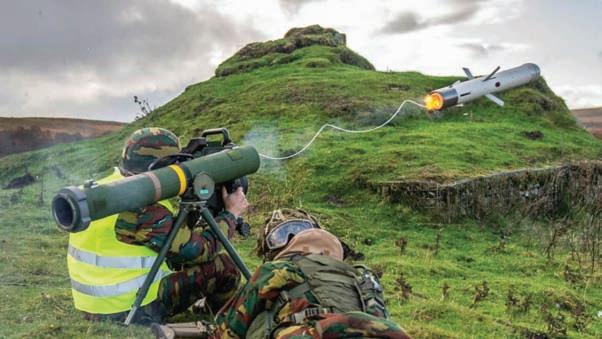
7 minute read
Eitan AFV Advanced Version Production Begins
PRODUCTION OF EITAN AFV ADVANCED VERSION BEGINS, TO BE OPERATIONAL BY 2021 END
Advertisement
By ARIE EGOZI
T
EL AVIV. Series production of the new very advanced Eitan 8x8 APC has begun but upgrade programs are already being evaluated. “This armored personnel carriers (APC) will perform some very important missions in combat,” an Israeli official told Raksha Anirveda. According to Israel Ministry of Defense (IMoD) and the Israel Defense Forces (IDF), the Eitan is the most advanced 8X8 APC currently operational. Some prototypes have been in use in different combat formations of the IDF.
“The Eitan has improved fire power by carrying the Rafael Spike LR anti-tank missiles, and improved protection by carrying the Elbit Systems Iron Fist active protection system,” Brig. Gen. Guy Paglin, head of the Merkava tank and the Eitan APC says.
The operational need for an 8x8 APC was realized especially after the Protective Edge operation in 2014. During this operation, the IDF used the little inventory of the Israeli made tracked NAMER and old M-113. To increase the protection level of the old M-113, they were loaded with sand sacks.
Eitan is expected to become operational at the end of 2021, replacing the half-century-old M-113 APC.
Eitan is Israel’s late entry into the wheeled APC type of combat vehicles. The wheeled type has become a favourite in many armed forces. This is due to speed and flexibility.
The Eitan will be built in three variants – an APC, a command vehicle and an infantry combat vehicle, equipped with an unmanned turret mounting a 30mm cannon and Spike missiles. Other configurations are expected to follow.
The displayed IMoD vehicles show different armor configurations, with an ‘Iron Fist’ active protection system installed on the variant with the unmanned turret. The vehicle is powered by a 750 hp engine and has a maximum road speed of 90 km/h. Operated by three crew members Eitan can carry a squad of nine fullyequipped soldiers in its fighting compartment. The vehicle has rear ramp access and roof hatches.
According to the IDF, the Eitan can travel at a speed of 55 miles/h and that gives it a major advantage when forces have to be transferred from one battle area to the other.
The Eitan is 26 feet long and 10 feet wide. It weighs 30 tons and this weight includes the ballistic armor and the active armor systems. The prototypes carried different sensors that give the three men crew, a real time situational awareness.
The basic turreted Eitan platform is likely to be used for moving infantry in the battle field, command and scout roles, while the turret less variant will be used to support specific configurations including weapon carriers (mortars etc.), combat engineering, recovery and casualty evacuation.
The IMoD is the main contractor of the Merkava 4, Namer and now of the Eitan. The directorate uses some 200 Israeli and American subcontractors.
Eitan will be equipped with an unmanned turret developed by the IMoD to the specific missions of this advanced APC. The turret will carry 12.7mm heavy machine gun and an ATK 30mm automatic cannon.
It will also be equipped with smoke dischargers and integral 60mm mortar, providing indirect fire capability, that includes high explosives, illumination, and smoke effects.
The IDF is evaluating equipping the Eitan with anti-tank missiles like the Spike LR made by Rafael that has a range of 2.5 miles.
The prototypes carried different sensors that gives the three men crew a real time situational awareness. These were tested in a long series of field tests.
Brig. Gen. Paglin said: “The 30 mm gun placed on the special turret has an elevation of 70 degrees which gives it a lot of advantages while the Eitan is used in urban warfare. This elevation allows the gunner to deal with high placed targets like enemy soldiers using all types of anti-tank weapons, which are very popular among terror organizations.”
As mentioned, the turret is designed to carry the 30 mm gun and some auxiliary systems, but according to Brig. Gen Paglin, after the Eitan is fielded in great numbers “other systems may be attached to the turret. It always happens after a combat platform is introduced into service; new operational demands are being met with new systems.”
The Ministry looks at the export option very seriously. After the IDF ground forces are equipped with enough Eitans, the export option will be on the table “there is an export potential,” said the high ranking officer.
As mentioned, the Eitan will carry the Elbit Systems Iron Fist active protection system against anti-tank rockets and missiles.
This system was selected in a competition against the Rafael Trophy.
The Iron Fist uses independent optical sensors, tracking radar, launchers and countermeasure munitions to defeat threats at a safe distance from the defended combat vehicles.
The system provides 360-degree protection coverage for closerange scenarios in both open terrain and urban environments. Its low size and weight, versatile high-performance, negligible residual penetration and ease of integration position IFLD as an optimal active protection solution for any fighting vehicle.
The Israel Defense Forces are getting ready for two main types of war – the one with Iran which is far away from Israel, and the other in Lebanon, Syria and Gaza.
The second type, which is sometimes called low intensity warfare, is now the most imminent.
This fighting will involve great numbers of infantry soldiers that will have to move fast and safe from one area to the other, while protecting themselves and inflicting casualties to the enemy.
To get ready for the future, the IDF decided to build a multidimensional unit – the aim to produce heavy and very accurate fire power to defeat the enemy as fast as possible.
At the beginning of 2019,
Eitan 8x8 APC
Israeli Spike ATGM in action with German Army

Israel’s Merkava tank in battle-ready mode

Brig. Gen. Guy Paglin, Head of the Merkava tank and the Eitan APC
the task to build the unit was assigned to the commander of the 98th Division, Brigadier General Finkelman, one of the elite commanders in the IDF who also specializes in combat methods.
Lt. Col. E with extensive operational experience and a deep understanding of target hunting and ground maneuvering in builtup areas was elected to command the unit, along with another Lt. Col. from the Air Force’s Shaldag unit, which specializes in air-toland liaison forces and special commando operations.
As part of the establishment process, outstanding fighters and officers were carefully selected from among the air crew members with knowledge and experience in operations with ground forces.
Among the goals set by Finkelman when the unit set out: writing an advanced and evolving concept in response to ground threats, rapid organisation to meet the goals and schedules set by the Chief of Staff, advanced and effective capabilities against the enemy, combat methods to streamline combat and shorten deadly cultural damage schedules, and Operation based on accurate real-time intelligence.
According to an IDF source, the unit’s commanders were able to prove that command and control systems and data transfer could be combined between fighter pilots, intelligence and ground forces in a way that would detect terrorists and a rapid and accurate attack on an unprecedented scale.
“The unit has been able to develop methods that will help the IDF to locate targets in enemy territory and attack them almost immediately with a variety of weapons systems to get the ultimate target- take this target out and I mean out completely,” the source said.
The very close cooperation between the unit and the air force has been demonstrated recently in a joint exercise the air force is a full partner in the multidimensional unit and is an integral part of the force building and the competence building.
The unit combines air crews, UAV operators, and special air force fighters along with the leading squadrons representing the range of aircraft in the Air Force’s possession, head of the participation division, Brig Gen Noam Riff said after the exercise.
How will the new APC fit into the new unit and the new type of warfare? Is the wheeled APC the right platform for such “fast and strong” offensive? The IDF is currently studying these issues and the result may bring to the installation of more advanced systems on the new Eitan.
-The writer is an Israel-based freelance journalist.










